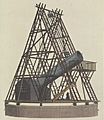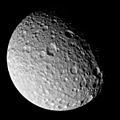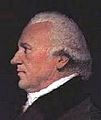William Herschel facts for kids
Sir Frederick William Herschel was a German-British astronomer. He is famous for discovering the planet Uranus in 1781. He also found infrared radiation, which is a type of light we can't see. Herschel was the first to discover binary stars, which are two stars orbiting each other. He also made important lists of stars and nebulae (giant clouds of gas and dust in space).
Herschel built many telescopes, including the biggest one in the world at that time. Before becoming a full-time astronomer, he was a talented musician. He played instruments like the cello, oboe, and organ. He even wrote many musical pieces, including 24 symphonies.
Contents
Early Life
William Herschel was born in Hanover, Germany, in 1738. He was one of ten children. His father was an oboe player in the Hannover Military Band. In 1755, William and his brother Jakob joined the band and went to England.
To avoid the Seven Years' War, the brothers left the band and moved to London. William was 19 years old and quickly learned English. In England, he started using the English version of his name, Frederick William Herschel.
Astronomy Discoveries
Herschel's love for music led him to study mathematics and lenses. This sparked his interest in astronomy. After 1773, he became very passionate about it. He even met the famous English Astronomer Royal, Nevil Maskelyne.
Herschel began building his own reflecting telescopes. He would spend up to 16 hours a day grinding and polishing the metal mirrors for his telescopes.
Discovering Uranus
When Herschel discovered Uranus, he wasn't actually looking for a planet. He was doing a survey of stars, so it was an accidental discovery!
Uranus was the first new planet found since ancient times. The first five planets—Mercury, Venus, Mars, Jupiter, and Saturn—can be seen without a telescope. They have been known for thousands of years. Uranus was the first planet discovered using a telescope.
Other astronomers had actually seen Uranus before, but they thought it was just a fixed star. Herschel noticed that it moved against the background of other stars. At first, he thought it might be a comet. A French mathematician, Pierre Laplace, used Herschel's measurements to figure out its orbit. This proved that it was indeed a planet.
Herschel wanted to name the new planet the 'Georgian star' after King George III. This made the King happy. However, the name didn't become popular. In France, people called it 'Herschel' for a while. Eventually, the name 'Uranus' was used everywhere.
In the same year, Herschel received a special award called the Copley Medal. He was also made a Fellow of the Royal Society. In 1782, he became "The King’s Astronomer." The King gave him money every year, which meant Herschel could stop working as a musician. He could now spend all his time on astronomy.
Herschel's Amazing Telescopes
During his life, William Herschel built more than 400 telescopes! His brother Alexander and his sister Caroline helped him a lot. They spent all their time assisting him.
His most famous telescope was a reflecting telescope. It had a main mirror that was 48 inches (1.2 meters) across. The telescope itself was 40 feet (12 meters) long. This was the largest telescope in the world from 1789 until it was taken apart 50 years later. The mirror was made from a hard metal alloy of tin and copper, which he polished by hand.
On August 28, 1789, the very first night he used this huge telescope, he discovered a new moon of Saturn. He found a second moon within the first month! However, the 40-foot telescope was hard to use. Most of his observations were done with a smaller, 18.5-inch (47 cm) telescope.
Herschel continued to build and sell telescopes to other astronomers. The money from these sales, along with the King's support, helped him and his siblings with their work.
Creating Star Catalogues
Herschel often worked with his sister, Caroline Herschel. She would write down his observations as he made them. In 1783, he gave Caroline her own telescope. She then started making her own astronomical discoveries, especially finding comets.
Caroline discovered eight comets and three nebulae. Her brother also suggested she update and correct an older work about the positions of stars by John Flamsteed. This new work was published as the British Catalogue of Stars. The Royal Astronomical Society honored her for this important work. Caroline also continued to be her brother's assistant.
Discovering Binary Stars
Herschel was the first to figure out that some "double stars" were not just two stars that looked close together from Earth. He found that they were actually true binary star systems. This means the two stars orbit around each other.
This was the first proof that Newton's laws of gravity work outside our own Solar System. Herschel discovered 850 binary stars and created the first list of them. His son, John Herschel, later found many more and added to this list.
Our Moving Solar System and the Milky Way
Herschel studied how the positions of stars changed compared to our Solar System. He noticed that some nearby stars moved quite quickly. He also discovered that our entire Solar System is moving through space!
By studying the movement of stars, he was the first to realize that our solar system is not standing still. He even figured out the general direction of this movement. He also studied the structure of the Milky Way galaxy, which is our home galaxy. He concluded that it was shaped like a flat disk. This was a very important discovery too.
The Discovery of Infrared Radiation
On February 11, 1800, Herschel was testing different filters for his telescope so he could safely observe sunspots. When he used a red filter, he noticed it produced a lot of heat.
Herschel discovered infrared radiation by doing a clever experiment. He passed sunlight through a prism. A prism splits light into its different colors, like a rainbow. He then held a thermometer just beyond the red end of the visible spectrum (the colors we can see). This thermometer was meant to measure the normal air temperature.
He was surprised when this thermometer showed a higher temperature than the visible light! Further tests led Herschel to realize there must be an invisible form of light beyond the red end of the spectrum. This invisible light was infrared radiation.
Family and Death
William Herschel and his wife Mary had one child, a son named John Herschel. In 1816, William was made a Knight by the Prince Regent, who later became King George IV.
Herschel died in 1822 at his home in Slough, England. He was 84 years old, which is the same number of years it takes for Uranus to orbit the Sun! His son John also became a famous astronomer. After William's death, his sister Caroline returned to Hanover, Germany. She lived to be 97 years old, passing away in 1848.
Herschel's house at 19 New King Street in Bath, Somerset is now the Herschel Museum of Astronomy. This is where he built many of his telescopes and first saw Uranus.
Images for kids
-
William and Caroline Herschel polishing a telescope lens (probably a mirror); 1896 lithograph
See also
 In Spanish: William Herschel para niños
In Spanish: William Herschel para niños












